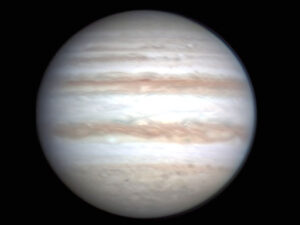Special to CosmicTribune.com, August 15, 2023
Excerpts from weekly Sky&Telescope report.
MONDAY, AUGUST 14
A winter preview: Step out before the first light of dawn this week, and the sky displays the same starry panorama it does after dusk around Christmas. Orion is striding up in the southeast, with Aldebaran and then the Pleiades high above it. His Belt is vertical.

TUESDAY, AUGUST 15
■ As summer progresses, bright Arcturus moves down the western side of the evening sky left of the Dipper.
THURSDAY, AUGUST 17
■ The actual Little Dipper is tipping over leftward in the north and is much fainter.
FRIDAY, AUGUST 18
■ Twilight challenge. About 30 minutes after sunset, look for the thin crescent Moon very low due west. Good binoculars or a telescope might be able to show faint Mars (magnitude +1.8) just below or lower left of it (at dusk in North America). Below them, Mercury is probably too low and faint now to see at all.
SATURDAY, AUGUST 19
■ Saturn climbs well up in the southeast by 10 or 11 p.m. Look below Saturn, by about two fists at arm’s length, for Fomalhaut, the Autumn Star already on its way up. No other 1st-magnitude star is anywhere near there to confuse the issue.
SUNDAY, AUGUST 20
■ The waning of August means that Scorpius, the proud starring constellation of the southern sky in July, is tilting over and lying down in the southwest after dark, preparing to bed down and drift off for the season.
PLANET ROUNDUP
Mercury and Mars are disappearing into the sunset. Both are relatively faint (magnitudes about +0.5 and +1.8, respectively). Mars is 5° above Mercury. The earlier in the week you try, the better your chances.
Jupiter (magnitude –2.5, in Aries) rises around 11 p.m. Watch for it to come up low in the east-northeast. By the beginning of dawn Jupiter shines very high in the south. Jupiter’s non-Red-Spot side on Aug 1, 2023Jupiter’s non-Red Spot side on August 1st, imaged by Christopher Go. South is up, north is down. Note the large extra-white region in the Equatorial Zone just above the North Equatorial Belt. An unusually long, thin blue festoon outlines the edge of the white region on its equator side.
Saturn (magnitude +0.5, in dim Aquarius) rises in twilight; it’s nearing its Aug. 26th opposition. After dark Saturn glows as the brightest thing low in the east-southeast. It’s highest in the south, and sharpest and steadiest in a telescope, by about 1 a.m.

You must be logged in to post a comment Login